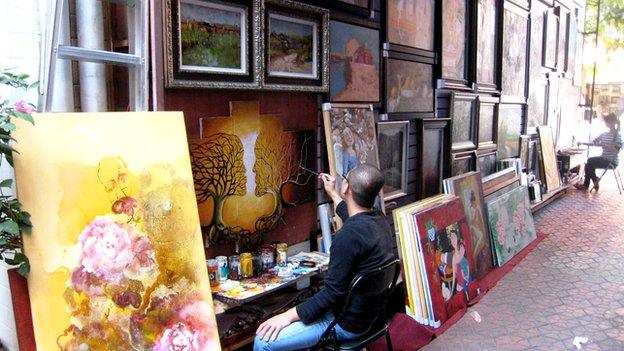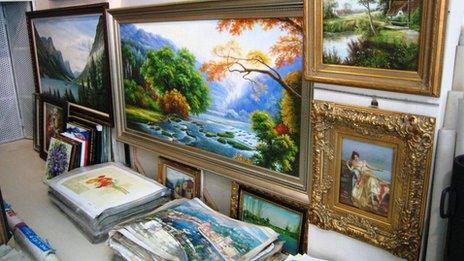China's oil painting village feels global shift
- Published

Business at Dafen Village thrived for years but the market is changing
Dafen oil painting village is one of the Shenzhen's key attractions, well known to mainland and foreign visitors.
It built its reputation on the ability of its estimated 5,000 artists to paint cheap, well-executed copies of famous Western paintings.
But in the last year, even the copy-art market has started to feel the impact of the global economic slowdown.
Many of the painters are finding ways of adapting their brush-strokes to the change in demand, reflecting a more general economic shift in a very visual way.
You know at once when you enter Dafen. Just a few minutes' walk from the main road, oil paintings appear on all sides.
They are displayed from floor to ceiling in the windows of every shop, hanging three or four deep along the walls of a labyrinth of alleyways.
In the past, Dafen artists churned out endless copies of iconic Western art. They were shipped mostly to buyers in Europe, especially Germany, and the United States.
There are still versions of Van Gogh, Monet and others on show, many set in heavy gilded frames.
But now the European staples are increasingly being replaced by Chinese traditional art.
'Big slump'
Ye Jianhong used to run a workshop of 500 artists. Then the global crisis hit. Now he has reduced his staff to about 30 and taken a job in sales to supplement his income.
He spoke to me in a well-stocked shop. On one wall, there was a small selection of Western reproductions.
Many of the pictures, though, were large-scale canvases of misty lakes, pagodas and jagged mountain tops, portraits of cheeky Chinese boys or archly posing Chinese beauties.
"We used to export a lot to overseas markets," he said.
"But now there's a big slump in sales. So we're shifting our focus to the domestic Chinese market. Chinese people are getting richer and richer."
He pointed to a pile of small canvases. An artist could typically paint 10 such copies a day, he said. He could knock out 20.
Now he was encouraging his artists to take time and improve the quality of their work.
I heard the same story again and again as I spoke to artists of all ages and styles in the village.
Overall figures were hard to verify but one local newspaper report said that exports fell by more than 50% in the first half of this year because of a collapse in Western orders.
'Bright colours'

More Chinese people are buying paintings from Dafen's artists
Further on, in a back alley, I bumped in to Weng Yuguo, a fashionable 27-year-old with spiky hair and trendy earrings. He was drawn to Shenzhen from his native Hainan Island and has been painting since he was 16.
His speciality? Classical Western still life oil paintings of flowers in Grecian urns.
When I first saw him, he was clutching a wet portrait of poppies, just finished, which he clipped to the wall to dry. Other examples of his work hung round it on the bare brick.
Each one, he said, took about three days to paint.
"Before I had some Western customers," he told me. "Now all my clients are Chinese."
He paused, looking from the wet pink poppies to the rather depressing tones of the old school classical flowers. Was there a relationship between the shift in global purchasing power and his artist's palette?
"There is a difference in taste," he said at last.
"I'd say that Westerners prefer classical pictures which tend to be very dark. Chinese people like bright colours."
- Published12 October 2012
- Published25 September 2012
- Published8 February 2012